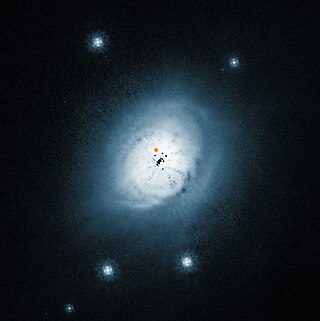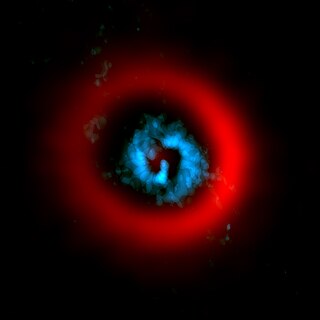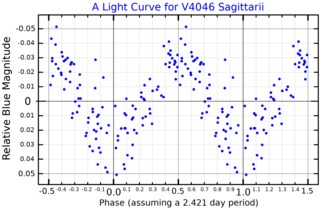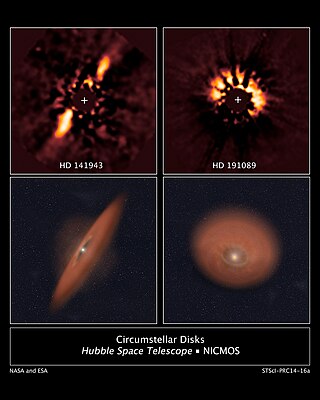
A protoplanetary disk is a rotating circumstellar disc of dense gas and dust surrounding a young newly formed star, a T Tauri star, or Herbig Ae/Be star. The protoplanetary disk may also be considered an accretion disk for the star itself, because gases or other material may be falling from the inner edge of the disk onto the surface of the star. This process should not be confused with the accretion process thought to build up the planets themselves. Externally illuminated photo-evaporating protoplanetary disks are called proplyds.

Ewine Fleur van Dishoeck is a Dutch astronomer and chemist. She is Professor of Molecular Astrophysics at Leiden Observatory, and served as the President of the International Astronomical Union (2018–2021) and a co-editor of the Annual Review of Astronomy and Astrophysics (2012–present). She is one of the pioneers of astrochemistry, and her research is aimed at determination of the structure of cosmic objects using their molecular spectra.

The Flame Nebula, designated as NGC 2024 and Sh2-277, is an emission nebula in the constellation Orion. It is about 1350 light-years away. At that distance, the Flame Nebula lies within the Orion B cloud of the larger Orion Molecular Cloud Complex.
In astronomy or planetary science, the frost line, also known as the snow line or ice line, is the minimum distance from the central protostar of a solar nebula where the temperature is low enough for volatile compounds such as water, ammonia, methane, carbon dioxide and carbon monoxide to condense into solid grains, which will allow their accretion into planetesimals. Beyond the line, otherwise gaseous compounds can be quite easily condensed to allow formation of gas and ice giants; while within it, only heavier compounds can be accreted to form the typically much smaller rocky planets.

HD 100546, also known as KR Muscae, is a pre-main sequence star of spectral type B8 to A0 located 353 light-years from Earth in the southern constellation of Musca. The star is surrounded by a circumstellar disk from a distance of 0.2 to 4 AU, and again from 13 AU out to a few hundred AU, with evidence for a protoplanet forming at a distance of around 47 AU.
51 Ophiuchi is a single star located approximately 410 light years away from the Sun in the equatorial constellation of Ophiuchus, northwest of the center of the Milky Way. It is visible to the naked eye as a faint, blue-white point of light with an apparent visual magnitude of 4.81. The star is moving closer to the Earth with a heliocentric radial velocity of –12 km/s.

A planetary-mass object (PMO), planemo, or planetary body is, by geophysical definition of celestial objects, any celestial object massive enough to achieve hydrostatic equilibrium, but not enough to sustain core fusion like a star.

AB Aurigae is a young Herbig Ae star in the Auriga constellation. It is located at a distance of approximately 531 light years from the Sun based on stellar parallax. This pre-main-sequence star has a stellar classification of A0Ve, matching an A-type main-sequence star with emission lines in the spectrum. It has 2.4 times the mass of the Sun and is radiating 38 times the Sun's luminosity from its photosphere at an effective temperature of 9,772 K. The radio emission from the system suggests the presence of a thermal jet originating from the star with a velocity of 300 km s−1. This is causing an estimated mass loss of 1.7×10−8 M☉ yr−1.

V4046 Sagittarii is a young binary consisting of two K-type main-sequence stars. The two stars are about 271 light-years away from the Earth. The two stars orbit each other every 2.42 days on a circular orbit.

HD 142527 is a binary star system in the constellation of Lupus. The primary star belongs to the Herbig Ae/Be star class, while the companion, discovered in 2012, is a red dwarf star or accreting protoplanet with a projected separation of less than 0.1″. The system is notable for its circumbinary protoplanetary disk and its discovery has helped refine models of planet formation. The orbit of companion is strongly inclined to the circumbinary protoplanetary disk.

A circumstellar disc is a torus, pancake or ring-shaped accretion disk of matter composed of gas, dust, planetesimals, asteroids, or collision fragments in orbit around a star. Around the youngest stars, they are the reservoirs of material out of which planets may form. Around mature stars, they indicate that planetesimal formation has taken place, and around white dwarfs, they indicate that planetary material survived the whole of stellar evolution. Such a disc can manifest itself in various ways.
Karin Ingegerd Öberg is a Swedish astrochemist. She is a Professor of Astronomy at Harvard University and leader of the Öberg Astrochemistry Group at the Center for Astrophysics | Harvard & Smithsonian. Her research concerns star formation, planet formation, and stellar evolution in relation to organic molecules, which are necessary to determine the origins of life on Earth and elsewhere. In April 2015, her group discovered the first complex organic molecule in a protoplanetary disk.

PDS 70 is a very young T Tauri star in the constellation Centaurus. Located 370 light-years from Earth, it has a mass of 0.76 M☉ and is approximately 5.4 million years old. The star has a protoplanetary disk containing two nascent exoplanets, named PDS 70b and PDS 70c, which have been directly imaged by the European Southern Observatory's Very Large Telescope. PDS 70b was the first confirmed protoplanet to be directly imaged.

HD 36112, also known as MWC 758, is a young Herbig Ae star located in the constellation Taurus, surrounded by irregular rings of cosmic dust. The system is about 3.5 million years old. The disk has a cavity at 50 astronomical units and two spiral arms at 30-75 au that are seen in near-infrared scattered light, but only one spiral arm is seen in ALMA images.

A circumplanetary disk is a torus, pancake or ring-shaped accumulation of matter composed of gas, dust, planetesimals, asteroids or collision fragments in orbit around a planet. They are reservoirs of material out of which moons may form. Such a disk can manifest itself in various ways.

Richard Van Evera Lovelace is an American astrophysicist and plasma physicist. He is best known for the discovery of the period of the pulsar in the Crab Nebula, which helped to prove that pulsars are rotating neutron stars, for developing a magnetic model of astrophysical jets from galaxies, and for developing a model of Rossby waves in accretion disks. He organized a US-Russia collaboration in plasma astrophysics, which focused on modeling of plasma accretion and outflows from magnetized rotating stars.

BP Tauri is a young T Tauri star in the constellation of Taurus about 416 light years away, belonging to the Taurus Molecular Cloud.
HD 100453 is a binary star system which lies in the constellation Centaurus about 350 light years away from the Sun and is a member of the open cluster Scorpius–Centaurus association.

CQ Tauri is a young variable star in the equatorial constellation of Taurus. It is too faint to be visible to the naked eye with an apparent visual magnitude that ranges from 8.7 to 12.25. The distance to this star is approximately 487 light years based on parallax measurements, and it is drifting further away with a radial velocity of ~23 km/s. It appears to be part of the T-association Tau 4. CQ Tauri lies close enough to the ecliptic to undergo lunar occultations.

IM Lupi is a young stellar object with a surrounding protoplanetary disk. The young star is suspected to host a still forming protoplanet at a distance of 110 astronomical units (AU) and a mass of 2-3 MJ. IM Lupi is 508 light-years distant.
















